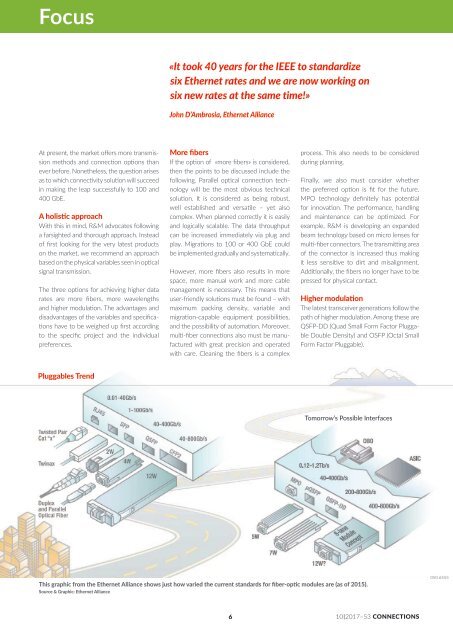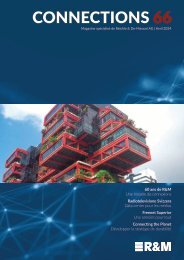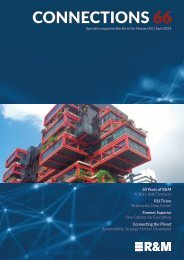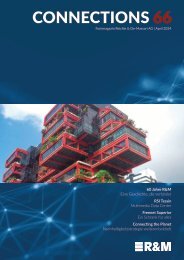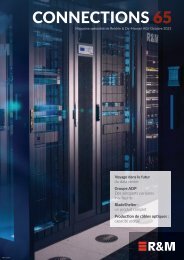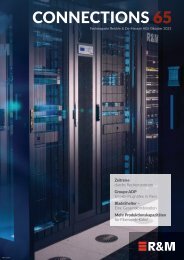CONNECTIONS_53-e
R&M specialist magazine CONNECTIONS no. 53
R&M specialist magazine CONNECTIONS no. 53
Create successful ePaper yourself
Turn your PDF publications into a flip-book with our unique Google optimized e-Paper software.
Focus<br />
«It took 40 years for the IEEE to standardize<br />
six Ethernet rates and we are now working on<br />
six new rates at the same time!»<br />
John D’Ambrosia, Ethernet Alliance<br />
At present, the market offers more transmission<br />
methods and connection options than<br />
ever before. Nonetheless, the question arises<br />
as to which connectivity solution will succeed<br />
in making the leap successfully to 100 and<br />
400 GbE.<br />
A holistic approach<br />
With this in mind, R&M advocates following<br />
a farsighted and thorough approach. Instead<br />
of first looking for the very latest products<br />
on the market, we recommend an approach<br />
based on the physical variables seen in optical<br />
signal transmission.<br />
The three options for achieving higher data<br />
rates are more fibers, more wavelengths<br />
and higher modulation. The advantages and<br />
disadvantages of the variables and specifications<br />
have to be weighed up first according<br />
to the specific project and the individual<br />
preferences.<br />
More fibers<br />
If the option of «more fibers» is considered,<br />
then the points to be discussed include the<br />
following. Parallel optical connection technology<br />
will be the most obvious technical<br />
solution. It is considered as being robust,<br />
well established and versatile – yet also<br />
complex. When planned correctly it is easily<br />
and logically scalable. The data throughput<br />
can be increased immediately via plug and<br />
play. Migrations to 100 or 400 GbE could<br />
be implemented gradually and systematically.<br />
However, more fibers also results in more<br />
space, more manual work and more cable<br />
management is necessary. This means that<br />
user-friendly solutions must be found – with<br />
maximum packing density, variable and<br />
migration-capable equipment possibilities,<br />
and the possibility of automation. Moreover,<br />
multi-fiber connections also must be manufactured<br />
with great precision and operated<br />
with care. Cleaning the fibers is a complex<br />
process. This also needs to be considered<br />
during planning.<br />
Finally, we also must consider whether<br />
the preferred option is fit for the future.<br />
MPO technology definitely has potential<br />
for innovation. The performance, handling<br />
and maintenance can be optimized. For<br />
example, R&M is developing an expanded<br />
beam technology based on micro lenses for<br />
multi-fiber connectors. The transmitting area<br />
of the connector is increased thus making<br />
it less sensitive to dirt and misalignment.<br />
Additionally, the fibers no longer have to be<br />
pressed for physical contact.<br />
Higher modulation<br />
The latest transceiver generations follow the<br />
path of higher modulation. Among these are<br />
QSFP-DD (Quad Small Form Factor Pluggable<br />
Double Density) and OSFP (Octal Small<br />
Form Factor Pluggable).<br />
Pluggables Trend<br />
Tomorrow’s Possible Interfaces<br />
9<br />
This graphic from the Ethernet Alliance shows just how varied the current standards for fiber-optic modules are (as of 2015).<br />
Source & Graphic: Ethernet Alliance<br />
050.6555<br />
6 10I2017–<strong>53</strong> <strong>CONNECTIONS</strong>


